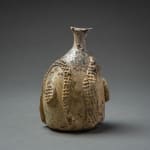Islamic Glass Sprinkler, 700 CE - 1000 CE
Glass
9.7 x 6.6 cm
3 3/4 x 2 5/8 in
3 3/4 x 2 5/8 in
LR.018
Early Islamic glass is often indistinguishable from late Classical/Byzantine and Sassanian models. The advent of Islam and the creation of a vast political empire did not have an immediate impact...
Early Islamic glass is often indistinguishable from late Classical/Byzantine and Sassanian models. The advent of Islam and the creation of a vast political empire did not have an immediate impact on the practices of glass-making workshops that had existed for centuries, especially in the Eastern Mediterranean coastal regions. By the seventh century most of the techniques used to work glass by hand had been perfected. The last major breakthrough occurred in the first century B.C. with the invention of glass-blowing. Rather than casting vessels in molds which was an expensive and time-consuming process, the blow-pipe increased the speed and efficiency of production. However, during the early centuries of Islam, glass-makers used this ancient technology in new ways to produce distinctively Islamic wares. They excelled in the application of decoration to blown wares and this small globular bottle is a perfect example of this trend.
The decoration of this vessel was carried out whilst the glass was still hot and thus in a malleable state. Trails of molten glass and glass discs were delicately applied to the surface of the body and imprinted with waffle-patterns. The spherical body is slightly irregular in shape and terminates in a narrow, flaring neck. Other bottles of this type have slightly wider necks. It is believed that the narrower ones were used as perfume sprinklers or to hold other expensive liquids that needed to be dispensed in small amounts. The production of glass vessels with this style of applied decoration seems to have been concentrated in the Syrian region.
The decoration of this vessel was carried out whilst the glass was still hot and thus in a malleable state. Trails of molten glass and glass discs were delicately applied to the surface of the body and imprinted with waffle-patterns. The spherical body is slightly irregular in shape and terminates in a narrow, flaring neck. Other bottles of this type have slightly wider necks. It is believed that the narrower ones were used as perfume sprinklers or to hold other expensive liquids that needed to be dispensed in small amounts. The production of glass vessels with this style of applied decoration seems to have been concentrated in the Syrian region.



